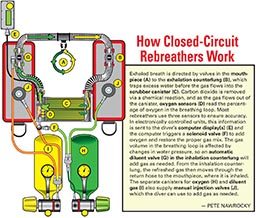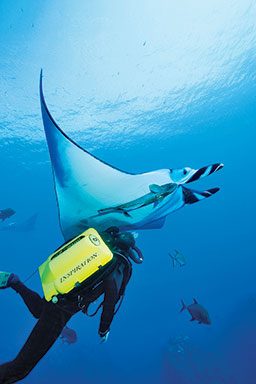At first glance, a closed-circuit rebreather (CCR) can seem a bit surreal. The primary components — large breathing hoses, small high-pressure tanks, a “scrubber” canister, counterlungs and (on some units) multiple computers — all look like something found in a sci-fi movie. But take a closer look, and the system starts to make more sense. And when you begin to understand how a CCR works, you begin to see how this different way to dive can open up whole new frontiers of underwater exploration.
Open-circuit scuba is the most common technology used by divers; it is simple, reliable and easy to use. The scuba regulator reduces the high-pressure air in a diver’s tank down to ambient pressure so the diver can breathe. Exhaled gas is then released into the water column, basically wasted. Now this isn’t a bad thing, but in order to make longer or deeper dives it is necessary to carry a large gas supply. Double 80 cu ft (2,265 L) tanks weigh approximately 90 lbs (41 kg) and create considerable drag for the diver to push through the water. Another drawback: The noise created by exhaled gas can scare away marine life.
The CCR Difference
Closed-circuit rebreathers use a different approach in supplying life support to the diver. At the heart of the system are the diver’s lungs, which move breathing gas through a closed, circulating loop. Every exhaled breath, of course, contains carbon dioxide and a diminished level of oxygen, so the rebreather’s primary tasks are to remove the carbon dioxide and replenish the life-sustaining oxygen.
This process begins in the scrubber unit, where a dry chemical removes the carbon dioxide from the breathing loop, and a series of sensors measures the remaining oxygen. In electronically controlled systems, these sensors signal a solenoid valve to add just enough pure oxygen to the mix to achieve the ideal partial pressure of oxygen (PO2) for the depth (see: “How Closed-Circuit Rebreathers Work”). In what are known as mass flow designs, the unit uses a calibrated orifice to inject oxygen and maintain a minimum PO2. The diver monitors a PO2 display and manually adds oxygen to the loop in order to reach a higher PO2.

A CCR adds only a small volume of oxygen to the system at a time, so a compact oxygen cylinder — usually 30 cu ft (850 L) — is all that is required for most dives. As a result, CCR divers plan their dives with their metabolic rate and PO2 preferences as the primary limitations on the depth and duration of a dive. A second cylinder holds a diluent gas, usually air for dives 150 feet (46 m)and shallower, though in advanced and deeper applications a properly trained diver may choose to use tri-mix. Diluent gas is added to the breathing loop during descent and during normal diving practices. The diluent bottle matches the size of the oxygen cylinder to provide a balanced, light (often less than 60 lbs or 23 kg), streamlined diving rig that provides hours of bottom time without the need for heavy double scuba tanks. Since the diver is breathing the ideal gas mixture at every depth, no-decompression limits can be substantially longer. And with virtually no exhaust bubbles, divers can better approach marine life.
CCR Training
CCR training and diving practices are substantially different from open-circuit scuba. First, the diver has to learn to think in terms of partial pressures of gases in relation to depth, whereas open-circuit divers need only to stay shallower than the maximum operating depth (MOD) of the gas they are breathing. CCR divers also need to be especially careful of rapid descents or ascents as PO2 levels change rapidly as ambient pressure changes.
Buoyancy control is different with a CCR. When a diver inhales on conventional scuba, the additional air in his lungs causes the diver to become positively buoyant and exhaling will cause him to become negatively buoyant. CCR divers, however, maintain a fixed volume of gas between their lungs and the rebreather at all times and experience unchanging buoyancy.

Classroom training concentrates on advanced diving concepts including partial pressures, gas consumption, workloads, oxygen set points, decompression planning, scrubber materials, bailout procedures and recovery procedures, to name a few. Divers train on a specific CCR unit and must get to know the system intimately. Maintenance is a high priority. CCR divers need to disinfect, assemble, test components, check for oxygen sensor reliability and perform positive and negative pressure tests before each dive. To avoid potential problems or missed steps, wise CCR divers employ checklists to assemble units before use.
Initial training dives focus on a variety of diving drills unique to rebreathers, including bailout techniques and the proper response to low and high oxygen warnings, oxygen failure and total gas failure. It is also necessary to learn how to add gases manually and maintain the proper partial pressure of oxygen. Many CCR divers also carry a redundant bailout system. Therefore, additional time is spent on properly configuring the individual diver’s gear to aid in streamlining.
Breathing on a CCR is a different feeling compared to open-circuit scuba, and it takes a few dives to get used to. With conventional scuba, divers are used to the feeling of air being injected by the regulator. But with a CCR, it’s your own breathing cycle that moves the gas. At first, it feels as though there is an inadequate supply of air, but the feeling soon passes as the diver gains experience. The second feeling is one of trust. The computer consoles constantly give information about depth, time, no-decompression limits and, most importantly, the PO2 circulating in the breathing loop.
It takes a few days of open-water training to begin to master the skills, but the more you dive with a CCR, the easier it is to understand what is going on. Training dives, designed to demonstrate CCR capabilities and build trust in the unit, may be as long as two hours. All in all, a CCR course can take as long as one week, depending on location and travel schedule.
The Payoff
After completing our initial training in a quarry, my buddy and I decided to test our skills in the St. Lawrence River on the wreck of the Keystorm. The wreck is more than 250 ft (76 m) long, intact and lying on its starboard side. Descending to the wreck required performing the necessary set-point changes on the computers. Then the fun began! It was almost unsettling how quiet the dive was and with no exhaust bubbles to dislodge sediment, visibility remained pristine as we made our way through the wreck.
Our second dive was to the wreck of the Gaskin. The dive plan called for a two-hour exploration with a maximum depth of 60 ft (18 m), though most of the dive would be to 50 ft (15 m) and shallower. Since we would be breathing at the optimum partial pressure of oxygen and moving into shallower depths as we went, we could enjoy a leisurely dive without incurring any decompression obligation. The beach entry point put us close to the ship, and as we approached in silence, we could hear a group of open-circuit divers on the wreck before it even came into view. We enjoyed a long, spectacular dive and surfaced surprisingly refreshed.
Diving a closed-circuit rebreather is not for every diver, nor is it for every diving situation. But it can be a fun experience and in the hands of a properly trained diver, a CCR system can be a powerful tool for exploring and enjoying the underwater world.
Closed-Circuit Rebreather Safety
While closed-circuit rebreathers (CCRs) have long been a tool of military and professional divers, only in the past few decades have technological advances made them widely available to recreational divers. Today there are about a dozen models on the market to meet the needs of divers who want to experience longer, deeper dives.
However, diving with a CCR requires skills and dedication well beyond that of open-circuit scuba. These systems are sophisticated machines, capable of reliably delivering ideal gas mixtures throughout the range of a dive, but they require close supervision by the user. In the case of equipment failure or operator error, a diver can be served a life-threatening breathing gas. If it happens without warning, the risk of death is high. Sadly, a review of DAN’s fatality surveillance data shows rebreather fatalities have increased since 2000 and now account for about 6 percent of known diving deaths.
CCRs allow divers to push the limits of our collective experience and current knowledge. We do not yet have the data needed for an evidence-based risk/benefit analysis for CCR diving, but it is clear that divers who choose this technology can minimize their risk by dedicating sufficient time for training and by adhering to best diving practices, including diving with a buddy and having appropriate topside support.
— Petar J. Denoble, M.D., D.Sc.
DAN Senior Research Director
© Alert Diver — Q4 Fall 2009